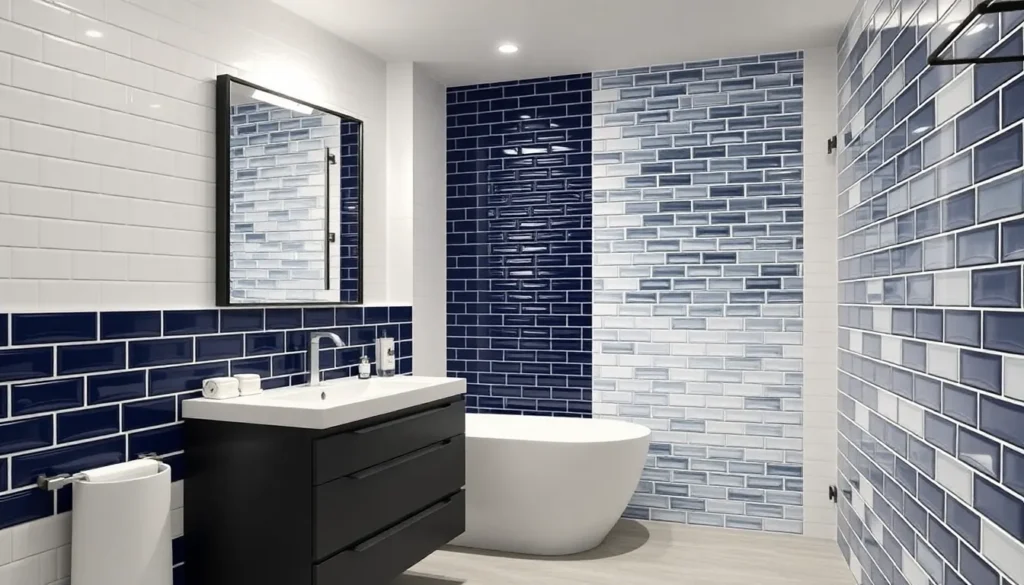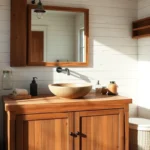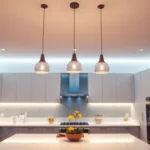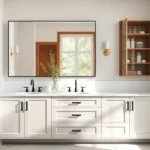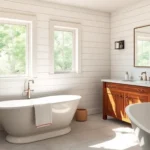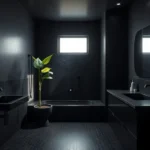Subway tiles have transformed from simple train station walls into one of the most versatile and timeless design elements in modern bathrooms. We’ve seen countless homeowners fall in love with these classic rectangular tiles because they effortlessly blend style with practicality, creating spaces that feel both contemporary and enduring.
What makes subway tiles so appealing is their incredible adaptability. Whether you’re dreaming of a sleek minimalist bathroom or a vintage-inspired retreat, we can help you discover the perfect subway tile arrangement to match your vision. From traditional white brick patterns to bold colored layouts and creative installation techniques, the possibilities are truly endless.
We’ll explore innovative ways to use subway tiles that go far beyond the basic horizontal layout. You’ll discover how different colors, sizes, and patterns can completely transform your bathroom’s personality while maintaining that coveted timeless appeal that makes subway tiles a smart investment for any home renovation project.
Classic White Subway Tiles With Dark Grout
Dark grout transforms the timeless appeal of white subway tiles into something truly spectacular. This combination creates visual interest while maintaining the clean aesthetic that makes subway tiles so beloved in bathroom design.
Charcoal Grout for Bold Contrast
Charcoal grout delivers the perfect balance between dramatic impact and sophisticated restraint. We’ve seen this pairing work exceptionally well in both small powder rooms and expansive master bathrooms, where the contrast highlights each individual tile without overwhelming the space.
The beauty of charcoal lies in its versatility with different lighting conditions. Natural light softens the contrast during the day, while artificial lighting in the evening emphasizes the grid pattern for a more structured appearance.
Maintenance becomes surprisingly manageable with charcoal grout since it conceals everyday wear better than lighter alternatives. This practical advantage makes it an excellent choice for high-traffic family bathrooms where durability matters as much as style.
Navy Blue Grout for Subtle Definition
Navy blue grout offers an unexpected twist that adds depth without sacrificing the classic subway tile appeal. This sophisticated choice works particularly well in coastal-inspired bathrooms or spaces with nautical design elements.
The deep blue creates gentle definition that’s more forgiving than stark black while still providing enough contrast to showcase the tile pattern. We recommend this combination for homeowners who want something unique but not too bold for their bathroom renovation.
Pairing navy grout with white subway tiles creates a timeless look that feels both traditional and contemporary. This versatility ensures your bathroom design won’t feel dated as trends evolve over the years.
Black Grout for Modern Drama
Black grout creates the most striking visual impact when paired with white subway tiles. This high-contrast combination transforms a simple tile installation into a bold design statement that commands attention.
The stark contrast works especially well in modern and industrial-style bathrooms where clean lines and dramatic elements define the aesthetic. We’ve noticed this pairing photographs beautifully, making it popular among homeowners who love sharing their renovation results on social media.
Black grout requires careful consideration of your bathroom’s size and natural light availability. Smaller spaces benefit from this contrast when paired with adequate lighting, while larger bathrooms can handle the drama without feeling cramped or overwhelming.
Colored Subway Tiles for Personality

Moving beyond traditional white, colored subway tiles offer endless opportunities to infuse personality into your bathroom design. We’ll explore how exact hues can transform your space with distinctive character and charm.
Sage Green Subway Tiles for Spa-Like Serenity
Sage green subway tiles create an instant spa-like atmosphere that promotes relaxation and tranquility. We recommend pairing these calming tiles with pale grout to enhance their soothing effect and maintain a cohesive, peaceful aesthetic. Vertical stack patterns work particularly well with sage green tiles, adding midcentury modern or Japandi design elements to your bathroom renovation.
These nature-inspired tiles complement natural materials like wood vanities and stone countertops beautifully. Installing sage green subway tiles from floor to ceiling can make smaller bathrooms feel more spacious while creating a cocoon-like retreat. We’ve found that brass fixtures and warm lighting enhance the organic feel of sage green installations.
Navy Blue Subway Tiles for Nautical Charm
Navy blue subway tiles bring sophisticated nautical charm to any bathroom space without overwhelming the design. We love combining these deep blue tiles with crisp white accents, chrome fixtures, and natural rope elements to achieve a classic coastal look. Their rich color adds depth and creates a striking focal point when used as an accent wall behind the vanity or in the shower area.
Pairing navy subway tiles with white subway tiles in alternating patterns creates visual interest while maintaining a cohesive design. Light-colored grout helps prevent the space from feeling too dark, especially in bathrooms with limited natural light. We recommend incorporating mirrors and glass elements to reflect light and enhance the airy feel of navy blue installations.
Blush Pink Subway Tiles for Feminine Touch
Blush pink subway tiles add a soft, romantic ambiance that works beautifully in powder rooms and master bathrooms alike. We suggest combining these delicate tiles with white fixtures and minimalist hardware to create an elegant, feminine aesthetic without overwhelming the space. Their subtle warmth complements both modern and vintage-inspired bathroom designs.
These gentle pink tiles pair exceptionally well with marble countertops, gold accents, and soft lighting to create a luxurious spa-like environment. Installing blush pink subway tiles in a classic brick pattern maintains their timeless appeal while adding personality. We’ve discovered that incorporating plants and natural textures enhances the organic, nurturing feel that blush pink tiles naturally provide.
Creative Subway Tile Patterns
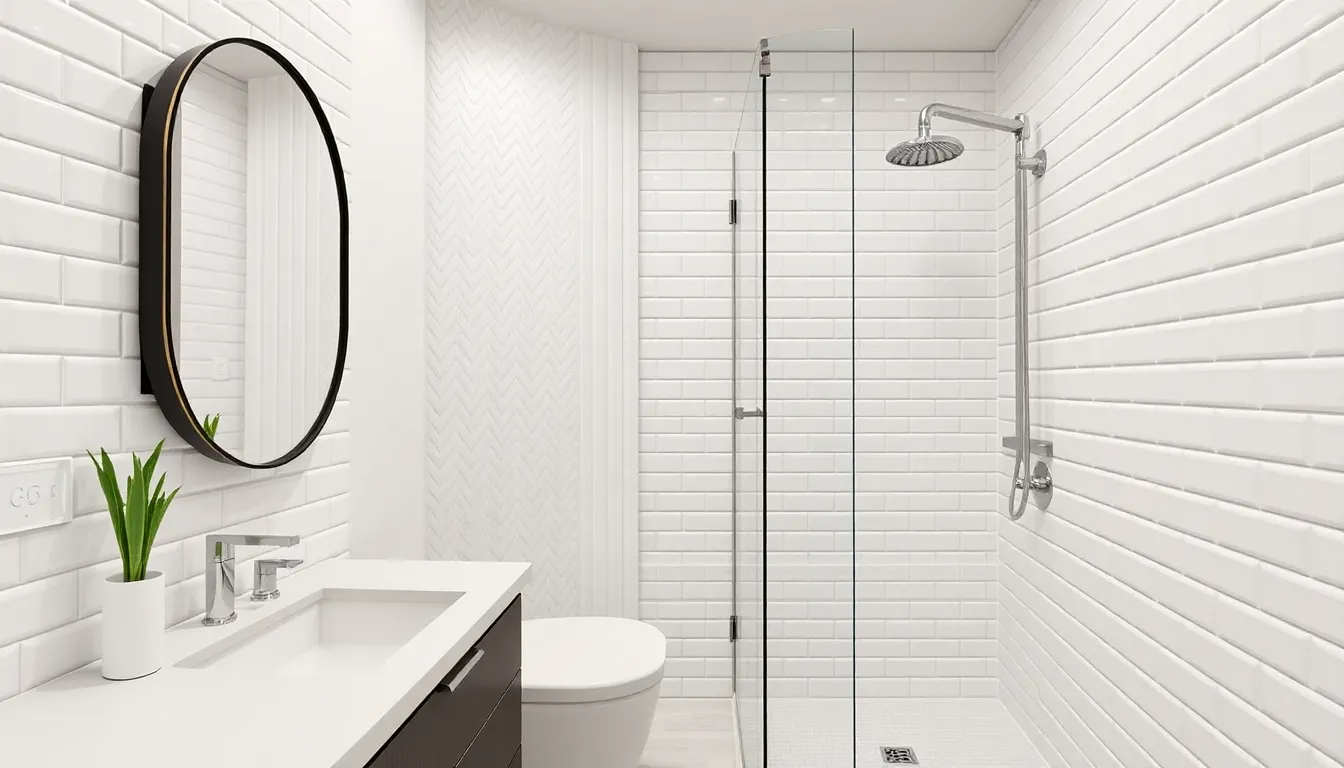
We’ll now explore innovative tile arrangements that transform your bathroom’s visual appeal through strategic placement and design.
Herringbone Pattern for Visual Interest
Arranging subway tiles in a herringbone pattern creates an elegant zigzag formation that instantly elevates your bathroom’s sophistication. We recommend this pattern for homeowners seeking to add texture and movement to their walls without overwhelming the space. The diagonal lines draw the eye across the surface, making even small bathrooms feel more ever-changing and captivating.
Installing herringbone subway tiles requires careful planning since each tile must be cut at precise angles to achieve the interlocking V-shape. We suggest starting with a center point and working outward to maintain symmetry throughout the installation. This pattern works exceptionally well behind vanities or in shower surrounds where you want to create a focal point.
Vertical Stack Pattern for Height Illusion
Stacking subway tiles vertically transforms the perceived height of your bathroom by drawing the eye upward along continuous grout lines. We find this technique particularly effective in bathrooms with standard 8-foot ceilings where you want to create an impression of greater space. The vertical orientation breaks away from traditional horizontal installations while maintaining the clean lines subway tiles are known for.
Implementing vertical stack patterns works best when you extend the tiles from floor to ceiling rather than stopping at a chair rail height. We recommend using this pattern on feature walls or in shower enclosures where the full height effect can be appreciated. The continuous vertical lines create a sleek, modern appearance that complements contemporary bathroom designs.
Offset Brick Pattern for Traditional Appeal
The offset brick pattern, also known as running bond, positions each row of subway tiles so they’re offset by half a tile length from the row above. We consider this the most classic subway tile arrangement since it mirrors the original installations found in early 20th century train stations. This traditional layout provides a timeless foundation that works with both vintage and contemporary bathroom styles.
Executing the offset brick pattern requires consistent spacing to maintain the staggered appearance that gives this layout its characteristic charm. We suggest using tile spacers and a level to ensure each row maintains proper alignment while creating the desired offset effect. This pattern distributes visual weight evenly across the surface, making it an excellent choice for large wall areas where you want consistent coverage without creating busy patterns.
Textured and Dimensional Subway Tiles
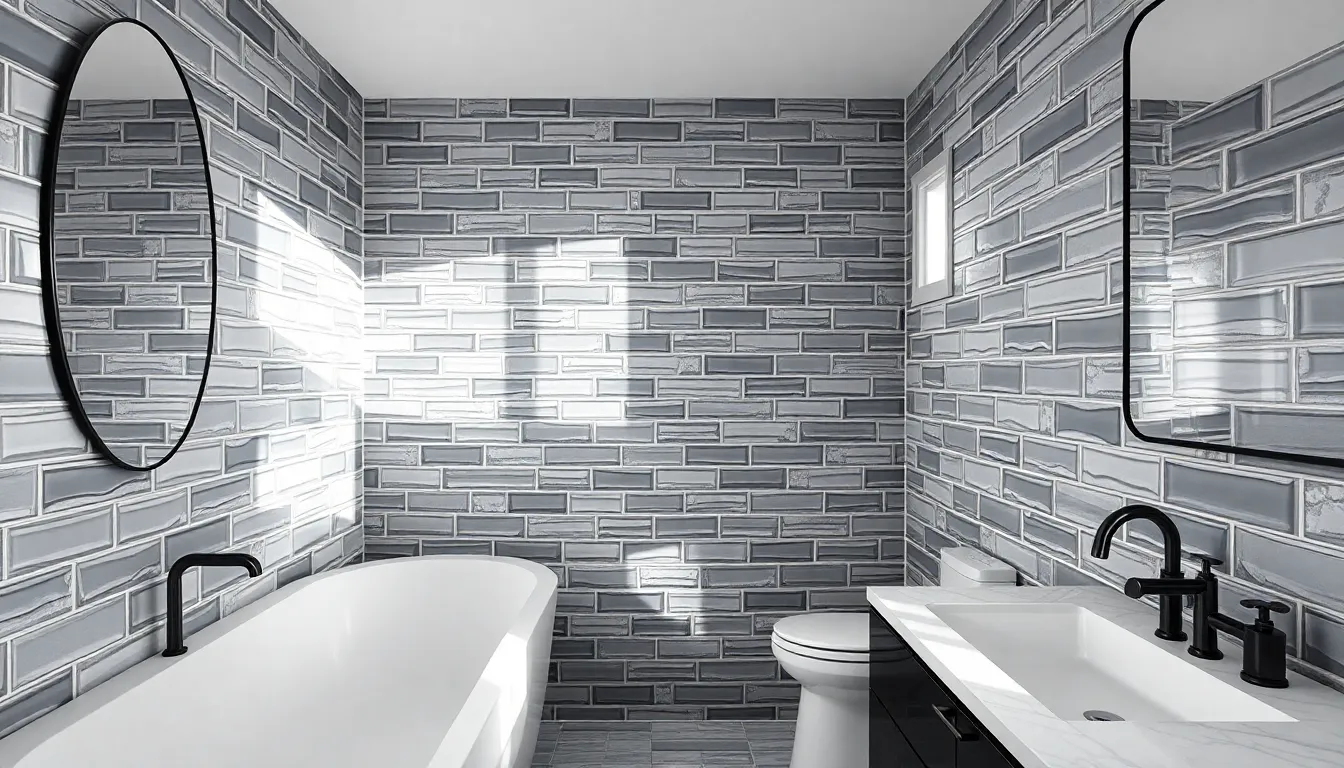
Moving beyond traditional flat surfaces, textured and dimensional subway tiles bring depth and visual intrigue to bathroom spaces. These innovative designs transform the classic subway tile from a simple backdrop into a captivating focal point.
Beveled Edge Subway Tiles for Classic Elegance
Beveled edge subway tiles create sophisticated depth through slightly angled edges that catch and reflect light beautifully. We’ve found these tiles enhance visual appeal by creating subtle shadows and highlights that add dimension to bathroom walls. The angled edges provide a timeless, sophisticated bathroom design that works particularly well in both traditional and contemporary settings.
Classic elegance emerges when these tiles are installed with precision, as the beveled edges create consistent shadow lines throughout the installation. Installation requires careful attention to ensure the beveled edges align properly for maximum visual impact. These tiles work exceptionally well in shower surrounds where the interplay of light and shadow creates a spa-like atmosphere.
Handmade Subway Tiles for Artisan Character
Handmade subway tiles introduce unique imperfections and character that mass-produced tiles simply can’t replicate. Each tile is crafted individually, offering a distinct artisanal feel that brings warmth and personality to bathroom spaces. We particularly appreciate how these tiles showcase slight variations in color, texture, and dimensions that create visual interest.
Artisan character shines through the subtle irregularities that make each installation truly one-of-a-kind. These handcrafted tiles often feature slightly uneven surfaces and edges that reflect the human touch in their creation. The natural variations in handmade tiles create a lived-in, authentic feel that complements both farmhouse and Mediterranean design styles perfectly.
Glossy vs Matte Finish Options
| Finish Type | Light Reflection | Cleaning Ease | Best Applications |
|---|---|---|---|
| Glossy | High reflection, brightens spaces | Easier to clean, shows dirt clearly | Small bathrooms, areas needing more light |
| Matte | Reduces glare, subtle appearance | Requires more maintenance | Calm environments, larger spaces |
Glossy subway tiles reflect light effectively, making bathroom spaces appear larger and brighter than they actually are. We recommend glossy finishes for smaller bathrooms where maximizing natural light is essential. These tiles are also easier to clean since dirt and grime are more visible against the reflective surface.
Matte finish tiles provide a more subtle appearance that reduces glare and creates a calm, low-key ambiance in bathroom settings. These tiles work ideally for creating serene environments where harsh reflections might be distracting. Matte surfaces require slightly more maintenance but offer a sophisticated, understated elegance that many homeowners prefer for master bathroom installations.
Mixed Material Subway Tile Combinations
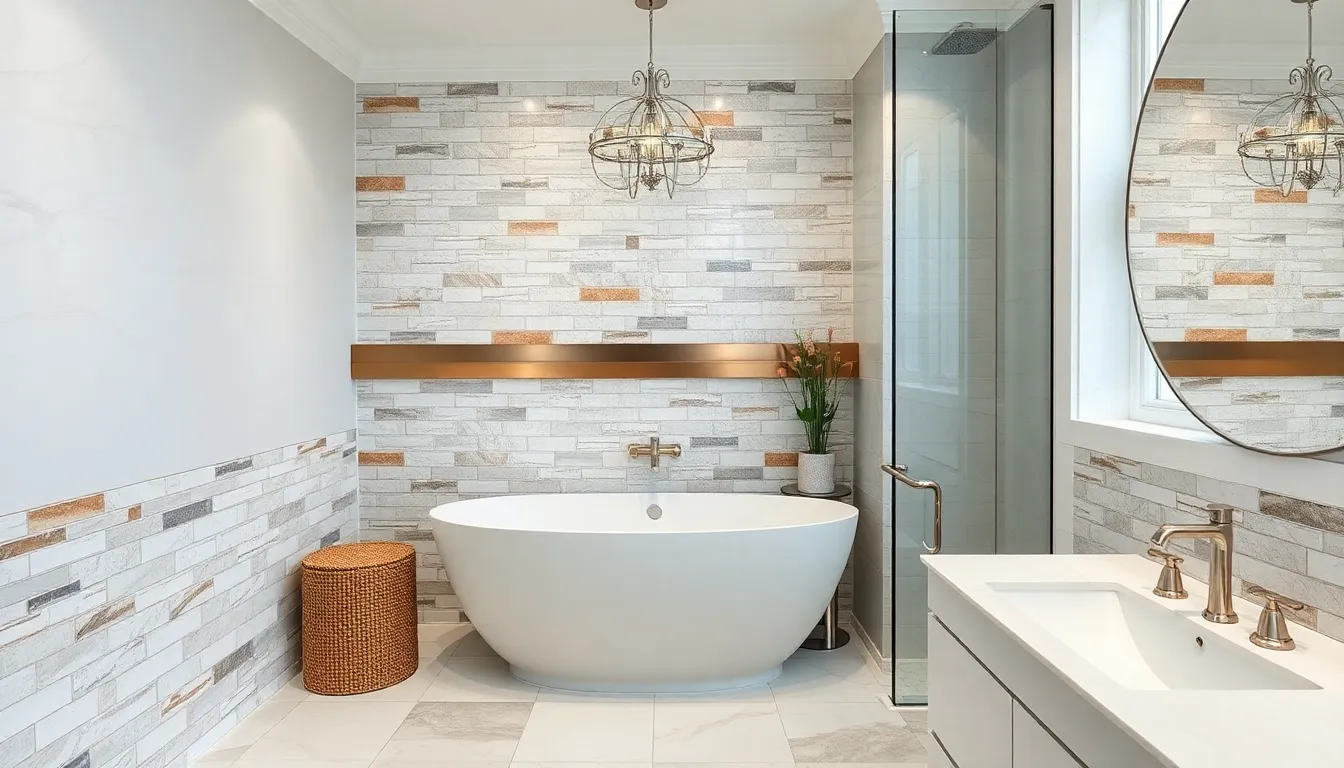
Combining subway tiles with other materials creates ever-changing focal points that elevate traditional bathroom designs. These partnerships allow us to achieve sophisticated looks that blend different textures and visual elements seamlessly.
Subway Tiles With Natural Stone Accents
Natural stone borders transform ordinary subway tile installations into elegant focal points. Marble accents paired with subway tiles create luxurious appearances that work beautifully on both walls and floors. These combinations enhance the overall elegance of bathroom spaces while providing textural contrast.
Stone accents work particularly well when positioned strategically around subway tile areas. Natural stone borders frame subway tile sections and add sophisticated transitions between different design elements. The pairing creates visual depth that makes bathrooms feel more custom and thoughtfully designed.
Marble Subway Tiles With Metallic Strips
Metallic strips between marble subway tiles add modern sophistication to bathroom designs. These accents create striking visual lines that enhance the natural beauty of marble while introducing contemporary elements. Gold toned accents provide luxurious contrast that elevates the overall aesthetic.
Incorporating metallic elements between tiles creates definition and adds dimensional interest. These strips catch light and create shimmer effects that make bathroom walls more visually captivating. The combination works especially well in spaces where we want to balance classic marble elegance with modern design touches.
Ceramic and Glass Subway Tile Blends
Ceramic and glass subway tile combinations offer versatile styling options with various color and texture possibilities. These blends allow us to create custom looks that suit different design preferences and lighting conditions. Glossy glass tiles add rich feels to bathrooms while ceramic tiles provide durability and warmth.
Glass subway tiles reflect light beautifully when paired with ceramic elements and pale grout. The combination creates layered visual interest that works well in both small and large bathroom spaces. These mixed material approaches give us flexibility to achieve unique designs that stand out from traditional single material installations.
Strategic Subway Tile Placement Ideas

Now that we’ve explored patterns and finishes, let’s examine how the placement and coverage of subway tiles can dramatically transform your bathroom’s visual impact and functionality.
Full Wall Coverage for Maximum Impact
Floor-to-ceiling marble subway tiles create an immediate sense of luxury and spaciousness in any bathroom. When we extend subway tiles from floor to ceiling on shower walls, the continuous vertical lines make the space feel dramatically larger. This technique works particularly well with marble subway tiles, where the natural veining adds subtle movement across the expansive surface.
Gold-toned accents enhance the design impact when paired with full wall marble installations. We’ve found that incorporating metallic fixtures or trim alongside floor-to-ceiling marble creates a sophisticated contrast that elevates the entire space. The uniform coverage provides a clean, modern aesthetic while maintaining the classic appeal that makes subway tiles timeless.
Full wall coverage delivers both contemporary style and traditional charm simultaneously. This approach eliminates visual breaks that can make spaces feel choppy, instead creating a seamless backdrop that allows other bathroom elements to shine.
Wainscoting Height for Traditional Style
Border trim positioned at wainscoting height transforms subway tiles into a classic design element. We recommend installing subway tiles to approximately 36 inches high, then capping them with decorative border trim for a refined traditional look. This approach creates distinct visual zones while maintaining the bathroom’s proportional balance.
Wainscoting height installations offer practical benefits alongside their aesthetic appeal. The lower portion receives subway tile protection in high-splash areas, while the upper wall can feature paint or wallpaper for added design flexibility. This traditional style works exceptionally well in vintage-inspired bathrooms and homes with period architecture.
Classic wainscoting creates timeless elegance that complements various bathroom styles. Whether you’re designing a farmhouse-inspired space or a formal powder room, this placement strategy provides the perfect foundation for layering additional design elements.
Shower Surround Focus for Practical Beauty
Shower wall emphasis using subway tiles creates stunning focal points while addressing practical moisture concerns. We focus subway tile installation primarily around the shower area, where water resistance is most critical. This targeted approach allows you to invest in higher-quality tiles for maximum visual impact without covering every bathroom surface.
Contrasting grout colors accentuate shower surrounds and make them standout features. When we use dark grout with white subway tiles or colored grout with neutral tiles, the shower area becomes an intentional design focal point rather than just a functional necessity. This technique draws the eye upward and creates visual interest in an otherwise utilitarian space.
Strategic shower surround placement balances budget considerations with design goals. By concentrating subway tiles in the shower area and using complementary materials elsewhere, we achieve sophisticated results while maintaining cost efficiency for bathroom renovations.
Subway Tile Size Variations
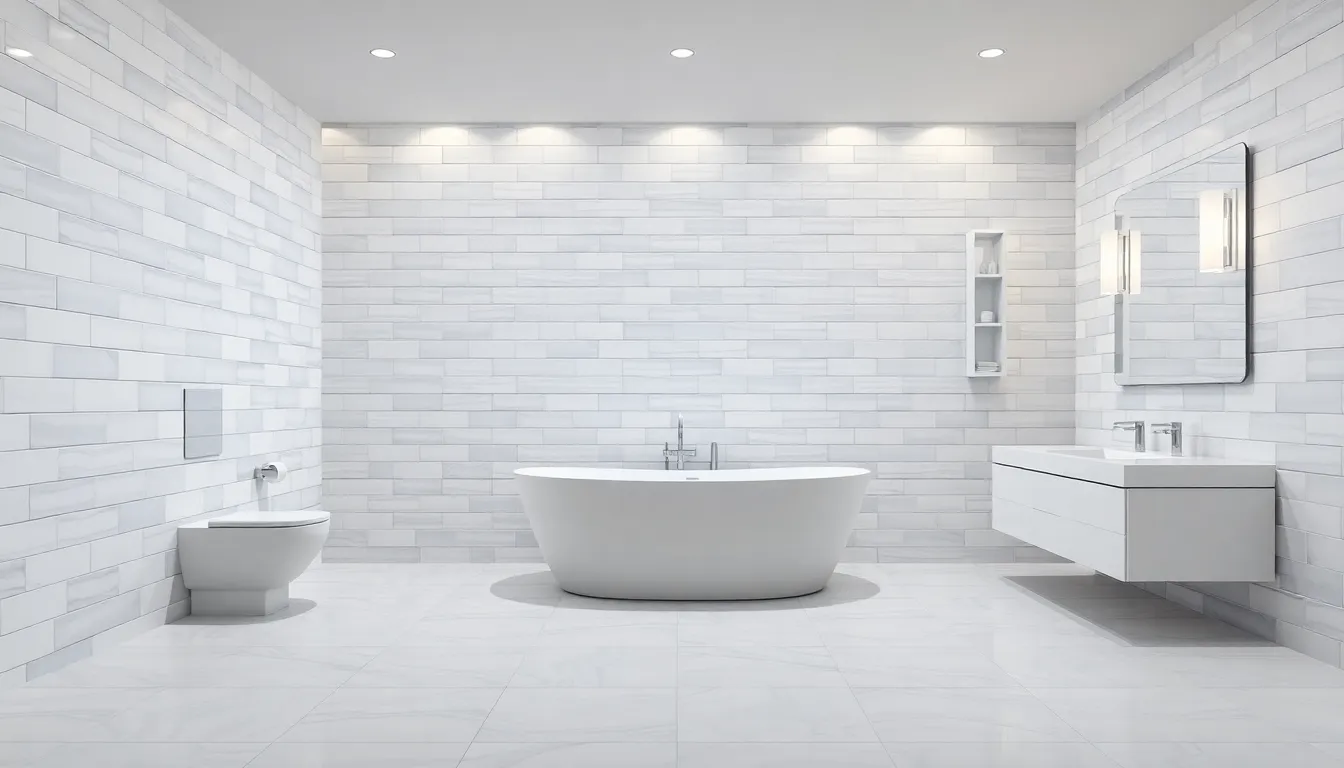
Choosing the right size subway tile can dramatically impact your bathroom’s overall aesthetic and spatial perception. We’ll explore three popular size options that cater to different design preferences and spatial requirements.
Large Format Subway Tiles for Modern Spaces
Large format subway tiles create a sleek and seamless appearance that’s perfect for contemporary bathroom designs. These oversized tiles minimize grout lines and emphasize the tile’s clean pattern, making them ideal for modern spaces where simplicity reigns supreme. We recommend using these tiles when you want to achieve a minimalist aesthetic that feels both sophisticated and uncluttered.
Maintenance becomes easier with large format tiles since there are fewer grout lines to clean and maintain. The reduced grout coverage also creates a more uniform surface that reflects light better, making your bathroom appear brighter and more spacious. Installation requires careful planning to ensure proper alignment, but the results deliver a polished look that complements modern fixtures and clean architectural lines.
Consider large format subway tiles for shower walls where you want maximum visual impact with minimal interruption. These tiles work exceptionally well in master bathrooms and contemporary renovations where the goal is creating a spa like environment that feels both luxurious and calming.
Mini Subway Tiles for Vintage Appeal
Mini subway tiles typically measuring 1×2 inches provide authentic vintage charm that’s perfect for retro and classic bathroom designs. These smaller tiles offer incredible detail and visual interest, allowing you to create intricate patterns that showcase craftsmanship and attention to detail. We find they work beautifully in powder rooms and guest bathrooms where you want to make a memorable impression.
Pattern possibilities expand significantly with mini subway tiles since their smaller size allows for creative arrangements like basketweave or diamond configurations. The increased grout lines add texture and depth to walls, creating visual complexity that larger tiles simply can’t achieve. Color coordination becomes crucial since both tile and grout colors play prominent roles in the overall appearance.
Installation requires patience and precision due to the many individual pieces, but the authentic period look justifies the extra effort. These tiles excel in vintage inspired renovations, Victorian style bathrooms, and spaces where historical accuracy matters more than modern convenience.
Standard 3×6 Subway Tiles for Versatility
Standard 3×6 subway tiles offer the perfect balance between visual impact and practical installation, making them the most adaptable choice for various bathroom styles. This traditional size works seamlessly in both modern and classic designs, providing enough surface area to showcase the tile while maintaining manageable grout line spacing. We recommend these tiles for homeowners who want flexibility in their design choices.
Budget considerations favor standard subway tiles since they’re widely available and competitively priced compared to specialty sizes. The familiar proportions make them easy to work with for both professional installers and DIY enthusiasts, reducing labor costs and potential installation errors. Material availability ensures you can find matching tiles for future repairs or renovations.
Design versatility shines with standard subway tiles since they adapt to many laying patterns including traditional offset, vertical stack, and herringbone arrangements. These tiles work equally well as accent features or full wall coverage, making them suitable for everything from small powder rooms to expansive master bathrooms where consistency and reliability matter most.
Grout Color and Spacing Considerations
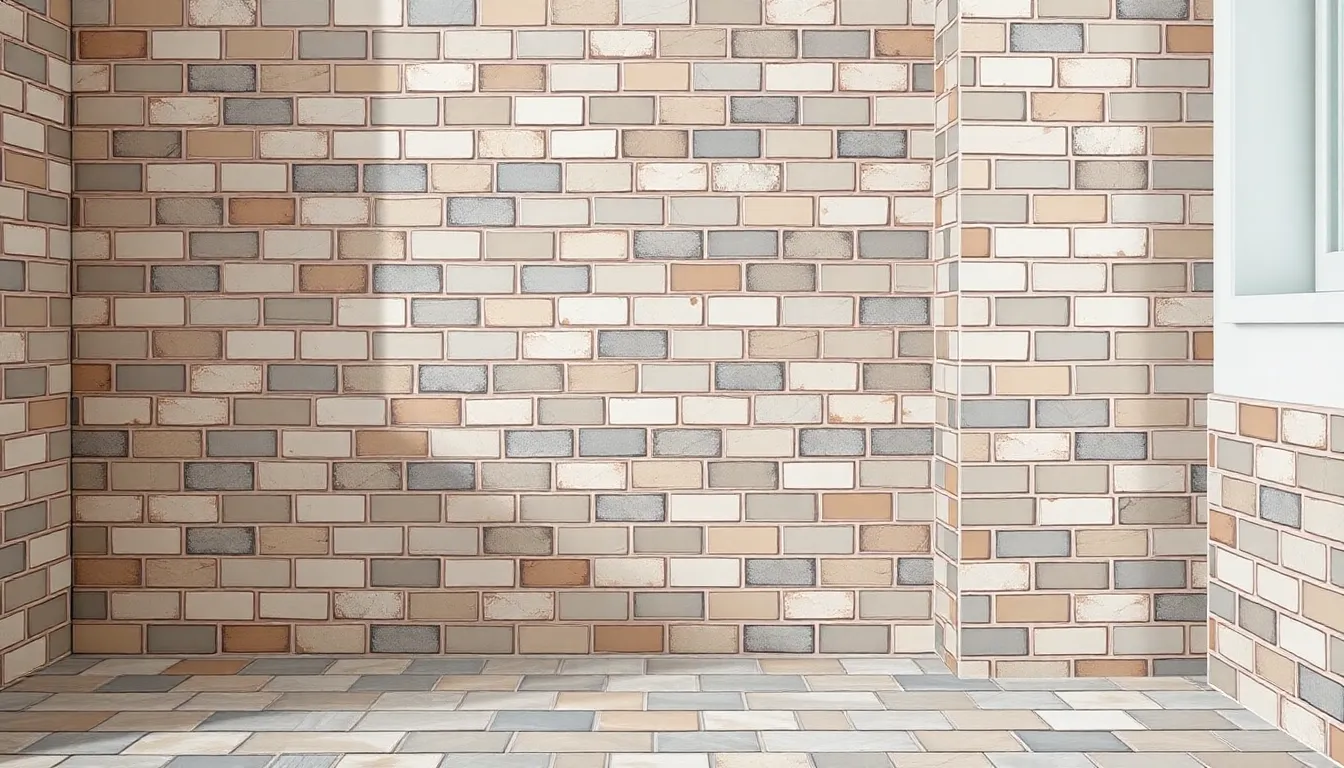
Your choice of grout color and spacing can completely transform the look and feel of your subway tile installation. These design decisions work hand in hand with your tile size and pattern choices to create the perfect aesthetic for your bathroom renovation.
Wide Grout Lines for Rustic Character
Wide grout lines instantly add rustic charm and vintage appeal to any subway tile installation. This approach works exceptionally well in farmhouse-style bathrooms where you want to emphasize the handcrafted, artisanal feel of your space. We recommend using grout lines that are 1/4 inch or wider to achieve this distinctive look.
Spacing your tiles generously creates visual texture that complements the imperfect edges of handmade subway tiles beautifully. The wider gaps allow each individual tile to stand out as its own design element rather than blending into a uniform surface. Traditional bathrooms benefit greatly from this treatment, especially when you pair wide grout lines with cream or off-white grout colors that enhance the vintage aesthetic.
Matching Grout for Seamless Appearance
Matching your grout color closely to your subway tiles creates a clean, contemporary look that maximizes visual space. This technique works particularly well in smaller bathrooms where you want to minimize visual interruptions and create an airy, open feeling. We’ve found that this approach makes bathrooms appear larger and more cohesive.
Seamless grout applications work best with precise, narrow grout lines that maintain the sleek appearance without drawing attention to the grid pattern. Modern and minimalist bathroom designs thrive with this treatment, as it reduces visual clutter and allows other design elements like fixtures and accessories to take center stage. Light-colored grout paired with white or light gray subway tiles achieves this effect most successfully.
Contrasting Grout for Grid Definition
Contrasting grout colors create bold, graphic statements that emphasize the geometric beauty of your subway tile pattern. Black grout with white tiles remains one of the most striking combinations, creating a grid pattern that adds visual interest and modern sophistication to any bathroom space. This approach works especially well in contemporary and industrial-style bathrooms.
Dark grout colors like charcoal or deep gray provide dramatic contrast while being more forgiving than pure black when it comes to maintenance and staining. We recommend this treatment for homeowners who want to make a design statement without overwhelming their space. The contrasting lines help define each tile individually, creating depth and dimension that transforms ordinary subway tiles into a compelling focal point.
Conclusion
We’ve covered everything from classic white tiles with dramatic grout choices to bold colored options that transform your space. Whether you’re drawn to sage green’s spa-like tranquility or navy blue’s nautical sophistication these versatile tiles adapt to any design vision.
The pattern possibilities are endless – from herringbone’s elegant texture to vertical stacks that create height illusions. Mixed materials and strategic placement give you even more creative control over your bathroom’s final look.
Remember that size matters too. Large format tiles offer modern minimalism while mini versions bring vintage charm. Your grout color and spacing choices will eventually tie everything together creating the perfect backdrop for your daily routines.
With so many options available subway tiles remain the smart choice for any bathroom renovation project.
Frequently Asked Questions
What makes subway tiles so popular for bathroom renovations?
Subway tiles are popular because of their timeless appeal and incredible versatility. Originally used in train stations, they’ve evolved into a design staple that adapts to any style – from minimalist modern to vintage charm. Their classic rectangular shape and clean lines make them suitable for both small and large bathrooms, while their durability ensures long-lasting beauty.
How does grout color affect the look of white subway tiles?
Grout color dramatically transforms subway tiles’ appearance. Dark grout like charcoal creates sophisticated contrast while remaining practical for maintenance. Navy blue grout adds depth without overwhelming the design, perfect for coastal themes. Black grout provides striking visual impact ideal for modern and industrial styles. Each choice offers different aesthetic and practical benefits.
What colored subway tiles work best for creating specific bathroom atmospheres?
Sage green subway tiles create spa-like serenity when paired with natural materials. Navy blue tiles offer sophisticated nautical charm, especially with white accents and light grout. Blush pink tiles provide romantic ambiance that complements both modern and vintage designs. Each color brings unique personality while maintaining subway tiles’ classic appeal.
Which subway tile patterns can make a bathroom appear larger?
The vertical stack pattern creates an illusion of height, making standard ceiling bathrooms feel taller. Herringbone patterns add elegance and texture while making small spaces feel more dynamic. The offset brick pattern provides a timeless foundation that balances traditional and contemporary styles, working well in various bathroom sizes.
What’s the difference between textured and smooth subway tiles?
Beveled edge subway tiles create sophisticated depth through angled edges that catch light beautifully. Handmade tiles offer unique imperfections and artisanal character that mass-produced tiles lack. Glossy finishes reflect light and are easier to clean, ideal for smaller spaces, while matte finishes provide calm ambiance better suited for larger bathrooms.
How can I combine subway tiles with other materials?
Natural stone accents like marble borders transform ordinary installations into elegant focal points. Metallic strips between tiles introduce modern sophistication and create striking visual lines. Ceramic and glass subway tile blends offer various color and texture possibilities, allowing for custom designs that reflect different styles and lighting conditions.
What size subway tiles should I choose for my bathroom?
Large format subway tiles create sleek, modern appearances with fewer grout lines for easier maintenance. Mini subway tiles offer vintage appeal and allow for intricate patterns with authentic charm. Standard 3×6 subway tiles provide versatility and practicality, suitable for various styles and budgets while maintaining classic proportions.
How does grout spacing affect subway tile installation?
Wide grout lines create rustic charm ideal for farmhouse-style bathrooms. Matching grout colors to tiles creates seamless appearances particularly effective in smaller spaces. Contrasting grout colors create bold, graphic statements that enhance the geometric beauty of subway tile patterns. Proper spacing planning is essential for achieving your desired aesthetic.

